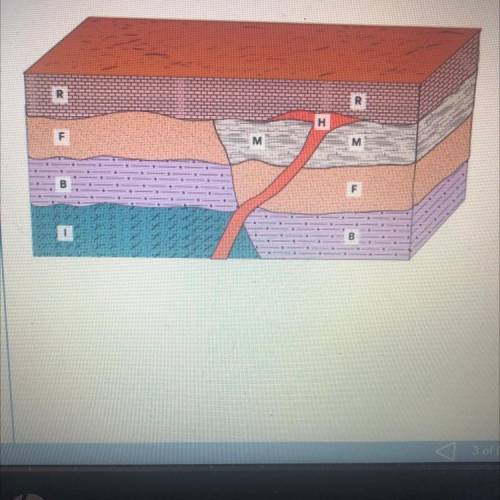
Physics, 17.05.2021 22:30 soonerlady19
A diagonal boundary seems to divide at least
layer F and layer B into two sections. Predict the
event that formed this boundary, and predict
whether the event occurred before or after the formation of the layers around it. Explain your
reasoning.
WILL MARK BE IF CORRECT HELP ME PKEASE NEED IT FAST


Answers: 2


Another question on Physics

Physics, 22.06.2019 17:40
Emmy kicks a soccer ball up at an angle of 45° over a level field. she watches the ball's trajectory and notices that it lands, two seconds after being kicked, about 20 m away to the north. assume that air resistance is negligible, and plot the horizontal and vertical components of the ball's velocity as a function of time. consider only the time that the ball is in the air, after being kicked but before landing. take "north" and "up" as the positive ‑ and ‑directions, respectively, and use ≈10 m/s2 for the downward acceleration due to gravity.
Answers: 2

Physics, 22.06.2019 21:30
Which sections of the heating curve illustrate this process?
Answers: 2

Physics, 22.06.2019 22:20
Which symbol in the first law of thermodynamics represents the sum of the chemical and thermal energy stored in atoms and molecules? a. q b.w c.v d.u
Answers: 3

Physics, 22.06.2019 23:00
Imagine an isolated positive point charge q (many times larger than the charge on a single proton). there is a charged particle a (whose charge is much smaller than charge q) at a distance from the point charge q. on which of the following quantities does the magnitude of the electric field created by charge q at particle a's position depend? check all that apply.the type of the charge on the charged particle athe relative orientation between q and a (while the distance between q and a is fixed)the specific location of the charged particle a (while the distance between q and a is fixed)the amount of the charge on the point charge qthe specific location of the point charge q (while the distance between q and a is fixed)the distance between the point charge q and the charged particle athe amount of the charge on the charged particle a
Answers: 3
You know the right answer?
A diagonal boundary seems to divide at least
layer F and layer B into two sections. Predict the
Questions


Mathematics, 28.05.2021 01:10

Mathematics, 28.05.2021 01:10



English, 28.05.2021 01:10








Geography, 28.05.2021 01:10

Mathematics, 28.05.2021 01:10

Advanced Placement (AP), 28.05.2021 01:10






